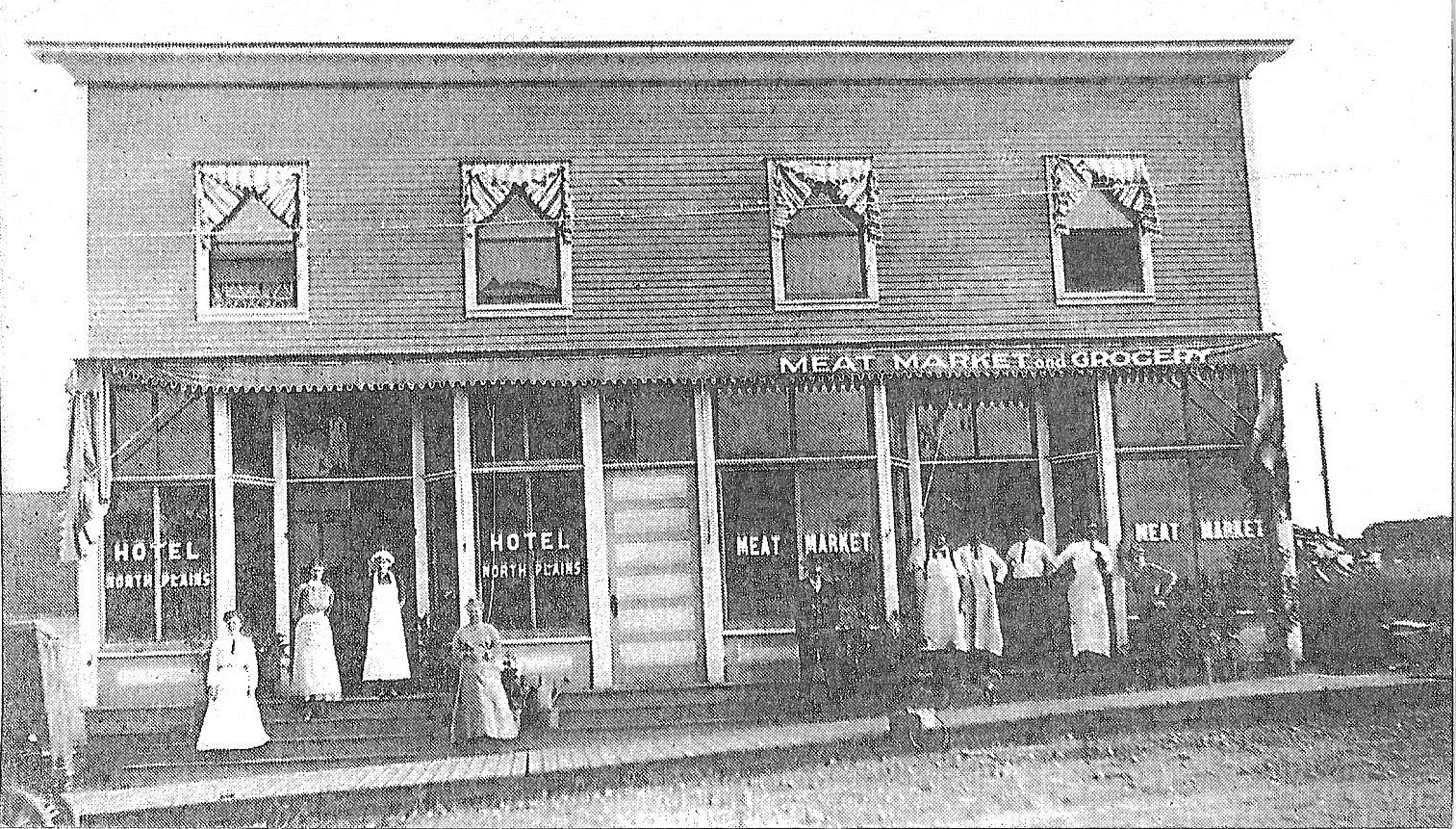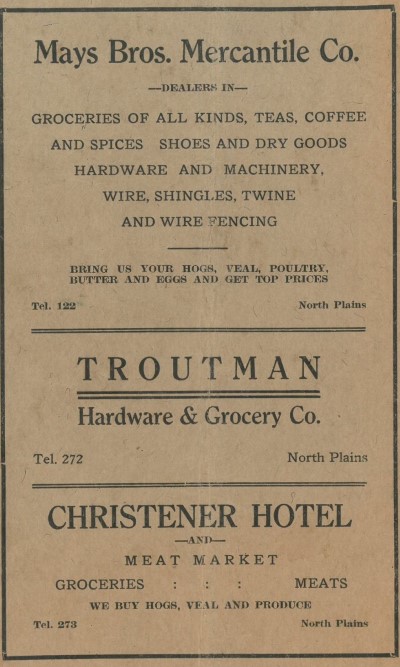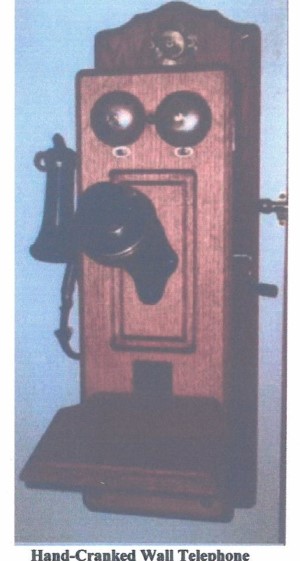North Plains History - North Side of Commercial Street
This is the third of many fun and interesting history articles we will be sharing written by local historian and 4th generation area resident Melvin Van Domelen. We sincerely thank Melvin for his wonderful historical accounts and for his passion for keeping our rich history alive today.
 The North Side of Commercial Street
The North Side of Commercial StreetNorth Plains had a hotel around 1911 that was owned by Carl Christner. This hotel was located on the north side of Commercial Street across from the parking lot between today’s North Plains Market and what locals refer to as the Lower Tavern (The Last Waterin’ Hole). A 2016 painting depicting this same hotel is represented on a mural in almost the exact same location of where it formerly operated. The building had a grocery store and a meat market on one corner. I suspect Andy Christner was connected to the operation of their meat market.
 A 1915 story in the North Plains Optimist, a weekly newspaper of that time, tells of Andy bringing back the beef. Around 1922, Bill and Ethel Troutman bought the building and opened a grocery store there. Prior to that they had operated a meat market in the corner of the building. I am going to switch over to the time my memory serves me, to about 75 years ago.
A 1915 story in the North Plains Optimist, a weekly newspaper of that time, tells of Andy bringing back the beef. Around 1922, Bill and Ethel Troutman bought the building and opened a grocery store there. Prior to that they had operated a meat market in the corner of the building. I am going to switch over to the time my memory serves me, to about 75 years ago. There was a fire in North Plains in 1937 that burned three buildings. This fire took out everything from where the Senior Center is today to the brick Pythian Hall. This burned the upper tavern, whose second floor had a storied reputation, and the post office. After the fire the Post Office was moved into the west side of the Troutman’s Store for a time. I remember the Troutman’s daughter, Jane Ann, as a cheerful, energetic young girl always helping the customers. Fritz Tschantz was a meat cutter in the store for quite a while. Troutman’s had a slaughterhouse down by McKay Creek. By the time I was in grade school, Troutman’s had refrigeration, something that Mays Brothers store lacked at that time. My parents had space rented in a frozen food locker there and I would go in with my mother. The store sold Dromedary ice cream and kept their supply in a space we would have to walk by. It was tough for a kid to go by all that ice cream and not get any, never!
I think it was in the mid 1940’s that Troutman’s build a small diner to the east that was joined to the store buildings by a few steps on one end. This restaurant resembled a boxcar. I was only in this diner a few times. Seems there was only a counter and stools to sit on. Sometimes the train would stop, and the crew would walk up to the diner for lunch. Some of the local farmers would that their harvest crews there to eat. I can remember being up in the Pythian Hall, waiting for my mother to get out of a Pythian Sisters meeting, and looking down at Troutman’s Store and the little diner at night. That picture is still in my mind. Just above the diner, across the street from the now Rogue Pub, was a small building used as a beauty shop by Blanche Stewart. This shop had three chairs, two hairdryers, and a shake-like exterior. To get a permanent wave here in those days was quite a process.
Merritt Jackson owned a garage on Commercial Street. Merritt was a descendant of the Ulysses Jackson family. Ulysses came to the Oregon Territory in the fall of 1848 and secured Donation Land Claim number 47 for 640 acres. This area extended from North Avenue to up beyond the Pumpkin Ridge Golf Course and cornered on Pumpkin Ridge Road to the northeast. This Jackson family is very prominent in local history. Merritt could fix almost anything. He once put a hydraulic hoist on my brother’s 1935 Chevrolet farm truck. There was a chain hoist in Merritt’s garage that I loved to play with. The garage burned once and was rebuilt. Abbey Creek Winery uses the building today.
When the garage burned, there was a lot of hunting ammunition stored inside. Exploding shells kept the firemen at a distance. To the right of the garage was a weathered old building that was just large enough to hold North Plains’ first school bus. This building leaned a bit to the east. I can’t remember a front door on it. The house just east of the Jackson Garage was the site of the telephone switchboard in the 1940’s. In earlier days the telephone operation may have had another location. I have a 1919 Pacific Telephone and Telegraph telephone directory (PICTURE) that had been mailed with a one-cent stamp. This is 9x6-inch heavy paper and covers an area from Cornelius to Scappoose. The phone numbers are on both sides, a few over 200. I still have the hand-crank wall telephone that was used in my grandfather’s house. His number was 10 F11. To ring that number, it would be one long crank that would ring a bell for the 10, two short cranks, or rings, signified the 11. The “F” stood for a farm line.
There were what were called party lines, ten or more homes on the same line. If you wanted to call someone on a different line, you would ring Center, the person on the switchboard, and give her the number you wanted to reach. She would then plug you into the other line. When your phone range, anyone on that line would hear it and could listen in…and did!
Central, the person working the switchboard, knew everything that was going on in the community. She knew who was in the hospital, and how they were doing, where the field fire was
 yesterday, or if anyone was hurt in the car wreck at Starkey’s Corner.
yesterday, or if anyone was hurt in the car wreck at Starkey’s Corner.At that time the customers and farmers owned, and were responsible for, maintaining the telephone lines. When a call went into the switchboard was when the Pacific Telephone Company system took over. Many men kept a long pole handy that was used to untangle the wires after a storm. One member of the Luck family up Dairy Creek was found dead in the creek after being out working on the telephone line. I think it was about 1947 that a company took over the whole telephone operation. Dial phones came in, and the hold hand crank wall phones were a thing of the past.





 Twitter
Twitter